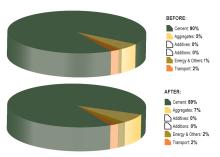The
As the cement industry’s global database of CO2 emissions and performance, the latest Getting the Numbers Right (GNR) data for 2011 shows that the industry has reduced its specific net CO2 emissions per tonne of cementitious product by 17% since 1990 (from 756kg/tonne to 629kg/tonne)1.
Cement is the essential glue to produce concrete and concrete is the most used man-made material in the world, twice as much as the total of all other building materials.
The ongoing trend of urbanisation in modern societies contributes to the increase in cement production and growth of the industry. Having said that, the GNR figures provide evidence of the gradual decoupling of emissions and cement output, which demonstrates the significant progress made by the industry: cement production by GNR companies increased by 74% between 1990 and 2011; absolute CO2 emissions increased by only by 44% over this period. Between 2010 and 2011, while cement production volume covered by the GNR increased from 840 million tonnes to 888 million tonnes (cementitious volume), specific net CO2 emissions have in fact decreased from 638 Kg/tonne to 629 Kg/tonne of cementitious product.
Philippe Fonta, WBCSD managing director, said: “GNR demonstrates how an effective measuring, reporting and verification system can be developed and managed for and by an entire industry sector. GNR has become established as a valuable source of independently verified emissions data, which is now used globally by the cement industry to improve energy efficiency and further reduce emissions. It is also accessed widely by policymakers, analysts and other interested stakeholders.”
According to the data, the four main drivers for the reduction in emissions are: (1) investment in more efficient kiln technology, (2) increasing use of alternative fuels such as biomass2, (3) reduction in clinker content3 and (4) an 8% decrease in electricity use per tonne of cement since 1990.
The 2011 data also now comprises 55% of cement production outside of China, with 96% coverage in Europe spanning 967 individual facilities. Four new country reports are released for the first time: Thailand, Morocco, Philippines and Egypt, providing more relevant national data in these countries. Improving the participation of cement companies in China and other emerging economies is a high priority for GNR.
Now in its seventh year of publication and the largest global database of its kind, the GNR is a voluntary, independently managed database of CO2 and energy performance information on the global cement industry.
The most recent data released is for 2011 in compliance with anti-trust legislation.
The GNR uses a common methodology for data collection and reporting, 94% of which is independently verified. Whilst the database is managed by the CSI, participation isn’t limited to its members. Cement producers worldwide are encouraged to report their emissions through the GNR project and cement trade associations have played a particularly active role in encouraging member companies to make their emissions data available.
GNR is based on the CSI’s Cement CO2 and Energy Protocol, which was derived from the Greenhouse Gas Protocol Corporate Accounting and Reporting Standard, developed by WBCSD and the World Resources Institute. This protocol is the most relevant guidance document for the measurement and reporting of CO2 emissions in the cement industry worldwide. It provides a common language, set of definitions and harmonised methodology for calculating CO2 emissions, with the aim of reporting them transparently.
The GNR data, which is available online at www.wbcsdcement.org/GNR can be filtered and viewed by region and other user-selectable parameters, allowing information to be accessed quickly and easily.
Note 1: For specific gross CO2 emissions the reduction was 15% over the same time span.
Gross CO2 emissions: direct CO2 emissions (excluding on-site electricity production) minus emissions from biomass fuel sources.
Net CO2 emissions: gross CO2 emissions minus emissions from alternative fossil fuels
Cementitious products are all clinker volumes produced by a company for cement making or direct clinker sale, plus gypsum, limestone, CKD, and all clinker substitutes consumed for blending, plus all cement substitutes produced. Clinker bought from third parties for the production of cement is excluded.
Note 2: While a few plants have been able to replace up to over 90% of conventional fuels, the global average replacement is around 13% in 2011 (compared to only 2% in 1990).
Note 3: Clinker-to-cement ratio exhibits some variations in different regions due to the specific minerals added in the concrete manufacturing process. Globally, the average % of clinker in cement is 76% (compared to 83% in 1990).







